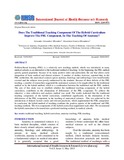Does the traditional teaching component of the hybrid curriculum improve the PBL component, in the teaching of anatomy?

View/
Date
2015-04-28Author
Missankov, A. Alexander
Missankova, I. Krassimira
Publisher
ScopeMed Journal Management SystemRights
Open AccessRights holder
International Journal of Health Sciences & ResearchType
Published ArticleMetadata
Show full item recordAbstract
Problem-based learning (PBL) is a relatively new teaching method, which was introduced in many medical schools as an alternative to the traditional method of teaching. At the beginning, the PBL method quickly gained popularity because of its many positive sides and particularly the one that allows early integration of basic medical and clinical sciences. A number of studies, however, reported that, in the PBL curriculum, the anatomical sciences (gross anatomy, histology and embryology) were insufficiently covered and the subjects were poorly understood by the students. Because of these deficits of the PBL teaching, a number of researchers suggested the anatomical sciences to be taught either by the traditional method or by the hybrid method, which is a combination between the traditional and the PBL method. The aim of this study was to establish whether the traditional teaching component, of the hybrid curriculum, contributes to the elimination of deficiencies of the PBL component. To achieve the objective, a data collection and analysis method was used. The results indicated that the traditional teaching component, of the hybrid curriculum, contributed significantly to the elimination of the deficiencies of the PBL component, in the teaching of anatomical sciences. This was achieved by the introduction of didactic lecture course and relevant practicals, which supplemented the PBL component. In conclusion, the hybrid method of teaching combines the positive aspects of the traditional and PBL teaching methods. The two components of the hybrid curriculum supplement each other. We recommend the hybrid curriculum to be turned into a preferred teaching method, in medical schools.
Collections
Related items
Showing items related by title, author, creator and subject.
-
The influence of quality assurance practices on supervision of teaching and learning in Botswana Primary Schools, a case of South-East Region
Phiri, Bame (University of Botswana, www.ub.bw, 2019-08)There has been a decline in academic performance in primary schools and quality assurance practices in primary schools have been in question. The gist of this study was to investigate the influence of quality assurance ... -
Levels of Information and Communication Technology integration in Mathematics teaching and learning at Junior Secondary School in Mahalapye region
Namasiku, Lesole Norah (University of Botswana, www.ub.bw, 2020-11)This study aims at finding out the levels of ICT deployment in Mathematics teaching and learning at Junior Secondary Schools in Mahalapye region, with the specific intent to explore the media used and how they are utilised ... -
A case report of an innovative approach to harnessing human resources at a Nursing school in Botswana
Sabone, Motshedisi; Kgositau, Mabedi; Massele, Amos (University of Botswana, www.ub.ac.bw, 2018-11-05)The paper aims at sharing how human resources limitation drove collaborative teaching at an international level. In 2012, shortage of manpower in face-to face teaching prompted the nursing school to harness human resources ...
